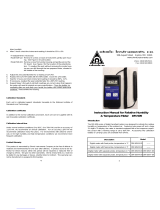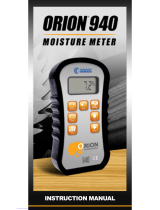
AquaLab 2 ABOUT AQUALAB
in determining product quality and safety. Water activity influences
color, odor, flavor, texture and shelf-life of many products. It predicts
safety and stability with respect to microbial growth, chemical and
biochemical reaction rates, and physical properties. For a more de-
tailed description of water activity as it pertains to products, please
refer to Chapter 3 of this manual, titled “Water Activity Theory.”
2.4 How AquaLab Works
AquaLab uses the chilled-mirror dew point technique to measure the
water activity of a sample. In an instrument that uses the dew point
technique, the sample is equilibrated with the head-space of a sealed
chamber that contains a mirror and a means of detecting conden-
sation on the mirror. At equilibrium, the relative humidity of the
air in the chamber is the same as the water activity of the sample.
In the AquaLab, the mirror temperature is precisely controlled by
a thermoelectric (Peltier) cooler. Detection of the exact point at
which condensation first appears on the mirror is observed with a
photoelectric cell. A beam of light is directed onto the mirror and
reflected into a photo detector cell. The photo detector senses the
change in reflectance when condensation occurs on the mirror. A
thermocouple attached to the mirror then records the temperature
at which condensation occurs. AquaLab then signals you by beeping
and displays the final water activity and temperature.
In addition to the technique described above, AquaLab uses an inter-
nal fan that circulates the air within the sample chamber to reduce
equilibrium time. Since AquaLab measures both dew point and sam-
ple surface temperatures simultaneously, it eliminates the need for
complete thermal equilibrium, thereby reducing measurement times
to less than five minutes for most samples. The AquaLab 4TEV and
4TEV DUO both use a capacitance humidity sensor to measure the
water activity of a sample. The sensor is suspended in the headspace
of the chamber and uses a special polymide material sandwiched be-
tween two electrodes to sense humidity changes. The sensor converts
the humidity value into a specific capacitance, which is then mea-
sured electronically by the circuit. This signal is then translated by
the software and displayed as water activity on the instrument screen.
5


























